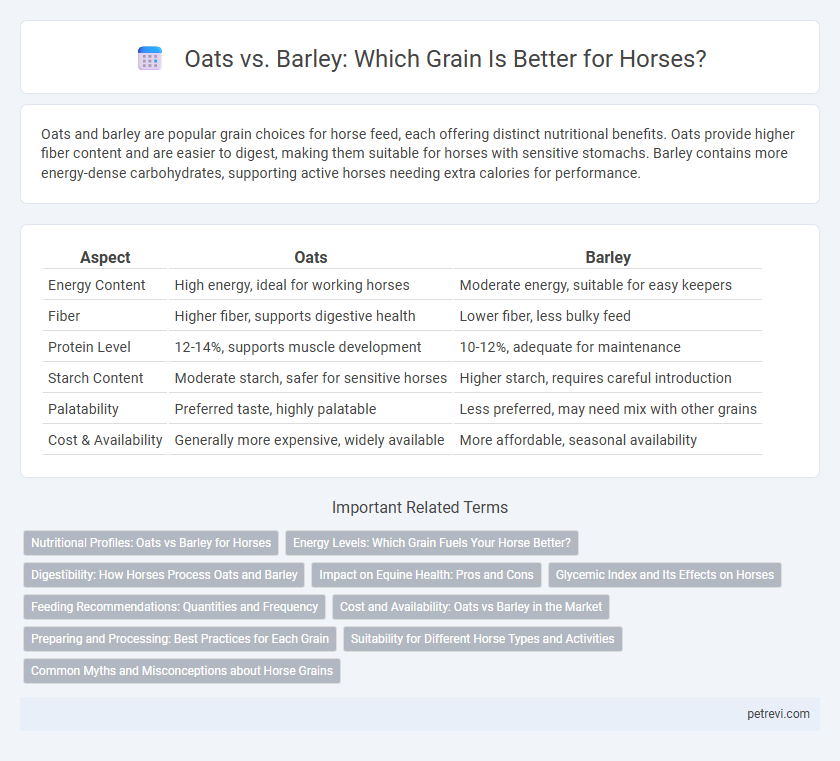Oats and barley are popular grain choices for horse feed, each offering distinct nutritional benefits. Oats provide higher fiber content and are easier to digest, making them suitable for horses with sensitive stomachs. Barley contains more energy-dense carbohydrates, supporting active horses needing extra calories for performance.
Table of Comparison
| Aspect | Oats | Barley |
|---|---|---|
| Energy Content | High energy, ideal for working horses | Moderate energy, suitable for easy keepers |
| Fiber | Higher fiber, supports digestive health | Lower fiber, less bulky feed |
| Protein Level | 12-14%, supports muscle development | 10-12%, adequate for maintenance |
| Starch Content | Moderate starch, safer for sensitive horses | Higher starch, requires careful introduction |
| Palatability | Preferred taste, highly palatable | Less preferred, may need mix with other grains |
| Cost & Availability | Generally more expensive, widely available | More affordable, seasonal availability |
Nutritional Profiles: Oats vs Barley for Horses
Oats provide a balanced nutritional profile for horses with high fiber content and moderate starch levels, promoting digestive health and steady energy release. Barley contains higher starch and protein but lower fiber than oats, making it more energy-dense but potentially harder to digest if fed in large quantities. Choosing between oats and barley depends on the horse's activity level, digestive sensitivity, and dietary energy requirements.
Energy Levels: Which Grain Fuels Your Horse Better?
Oats provide a moderate energy release with high fiber content, promoting steady digestion and enduring stamina for horses engaged in light to moderate work. Barley contains higher starch levels, delivering quicker energy bursts suitable for performance horses needing rapid fuel but requiring careful management to prevent digestive upset. Choosing between oats and barley depends on your horse's workload and digestive sensitivity, balancing sustained energy versus immediate power demands.
Digestibility: How Horses Process Oats and Barley
Oats offer high digestibility due to their loose hull, allowing horses to efficiently extract energy and nutrients with minimal digestive upset. Barley has a tougher hull and higher starch content, which can be more challenging for horses to digest and may require careful processing to improve nutrient availability. Horses typically process oats more quickly, reducing the risk of colic or starch overload compared to barley.
Impact on Equine Health: Pros and Cons
Oats provide a high-energy grain with a balanced fiber content, promoting better digestion and reducing the risk of colic in horses. Barley offers higher starch levels but can be harder to digest, potentially causing digestive disturbances if fed excessively. Careful management of oat and barley intake is essential to maintain optimal equine health and performance.
Glycemic Index and Its Effects on Horses
Oats have a lower glycemic index compared to barley, resulting in a slower release of glucose and more stable blood sugar levels in horses. This makes oats a suitable grain for horses prone to insulin resistance or laminitis, as it reduces the risk of sudden spikes in blood glucose. Barley, with its higher glycemic index, can cause rapid glucose absorption, which may lead to increased insulin response and metabolic stress in sensitive horses.
Feeding Recommendations: Quantities and Frequency
Oats provide a high-fiber, moderate-energy grain suitable for horses requiring consistent energy intake, typically fed at 1 to 2 pounds per 100 pounds of body weight daily, divided into two or three meals. Barley offers a denser energy source with higher starch content, recommended at lower quantities--around 0.5 to 1 pound per 100 pounds of body weight per feeding--to prevent digestive upset, usually given once or twice daily. Feeding frequency should align with the horse's workload, digestive health, and dietary needs, ensuring gradual introduction and balanced forage intake to maintain optimal gut function.
Cost and Availability: Oats vs Barley in the Market
Oats are generally more expensive than barley but are highly favored for horse feed due to their higher fiber content and digestibility. Barley tends to be more readily available and cost-effective, especially in regions with large grain production, making it a practical choice for budget-conscious horse owners. Market fluctuations and local agricultural trends significantly impact the price and accessibility of both grains.
Preparing and Processing: Best Practices for Each Grain
Oats should be cleaned thoroughly to remove husks and dust before feeding, promoting better digestion and nutrient absorption in horses. Barley requires steam rolling or flaking to break down the hard outer shell, enhancing palatability and digestibility. Both grains benefit from soaking to reduce choke risk and improve nutrient availability in equine diets.
Suitability for Different Horse Types and Activities
Oats provide a high-fiber, easily digestible grain ideal for performance horses requiring quick energy boosts during intense activities like racing or polo. Barley, with its higher starch content and slower digestion rate, suits mature, less active horses needing sustained energy without rapid glucose spikes. Selecting oats or barley depends on the horse's workload, metabolic health, and digestive tolerance to optimize energy levels and maintain digestive efficiency.
Common Myths and Misconceptions about Horse Grains
Oats are often preferred for horses due to their high fiber content and palatability, but barley offers a more energy-dense option with higher starch levels, debunking the myth that oats are categorically superior. Misconceptions include the belief that barley causes digestive issues more frequently; however, when properly processed and introduced gradually, barley is just as safe and nutritious. Both grains should be balanced according to the horse's workload and digestive tolerance to optimize health and performance.
Oats vs Barley for Horse Grains Infographic

 petrevi.com
petrevi.com